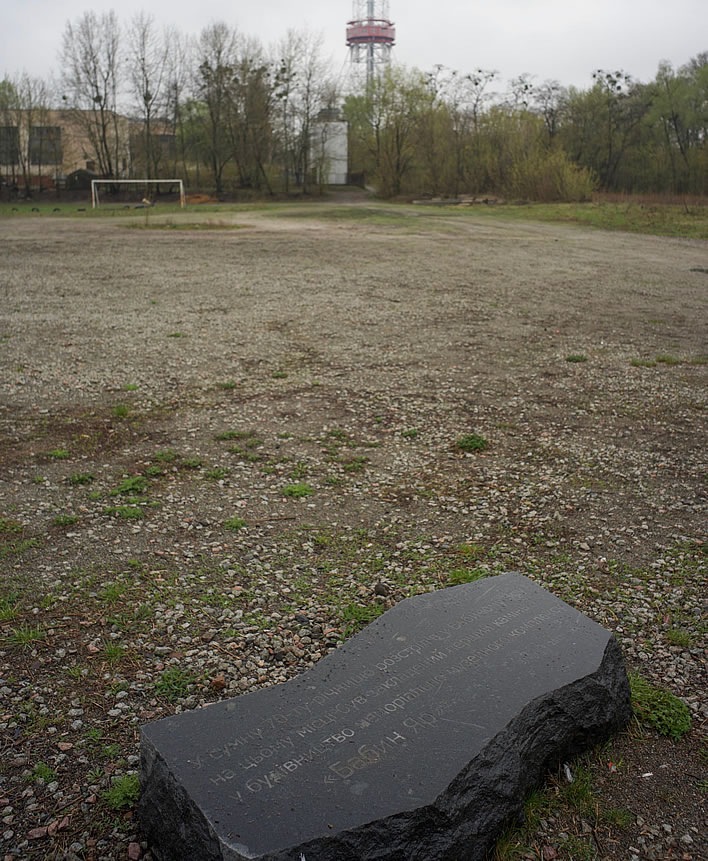Babi Yar
Posted by Mad Mitch on UTC 2016-10-03 10:41 Updated on UTC 2019-07-28
Over the next five years, as the 75-years-ago cursor rolls over the years 1941 to 1946, we shall have an almost daily opportunity to mark some outrage or other.
Today's outrage would be the massacre of Babi Yar near Kiev that took place on 29 and 30 September 1941 during the Germans' push through Ukraine. 33,771 Jews – one can rarely fault the Germans for their bookkeeping – were marched line by line into a deep ravine at a brickworks, made to lie on the corpses of the previous line then shot in the back of the head. The German Army, the SS and the local police worked in balletic harmony.
We select Babi Yar for notice today because it was the largest execution of its sort that took place in the Soviet Union. It can stand as a proxy for all the other, smaller, actions of 'cleansing' that occurred during the Germans' presence in the East. There were a lot of them. After the systematic executions of 29 and 30 September, Babi Yar was used as an execution site for two more years. More shooting, but less bookkeeping: we have to guess – 100,000? 200,000? Who knows?
During their retreat in 1944 the Nazis tried to hide what they had done, thinking that subsequent generations of Germans in the 1,000-year empire might not understand what had to be done to ensure that they were freed from the semitic pestilence. In Babi Yar the retreating army forced Russian prisoners to exhume the corpses and burn all traces. The action was incomplete. In their haste the army blew up the ravine with whatever human remains it still contained.
Nearly all of these outrages went unremedied. After the war, a handful of top-level commanders were hung or committed suicide at Nuremburg. The great mass of participants – the officers, the pullers of triggers, the herders, the guards, the police, the officials, the underlings who prepared the executioners' lunches in the field kitchens – all those who survived the other horrors of the eastern front slipped back into postwar Germany, clutching their Persilscheine. Postwar Germany was a country that was rebuilt by not asking too many questions. The myth of the NS-Gewaltherrschaft was gratefully seized upon, a myth in which a few madmen forced 50 million innocent people unwillingly to do their bidding. Perhaps nations, just like people, have to draw a line between themselves and their past, a line that they never cross in order to preserve the sanity of their present.
And last, the rending pain of re-enactment
Of all that you have done, and been; the shame
Of motives late revealed, and the awareness
Of things ill done and done to others' harm
Which once you took for exercise of virtue.[1]
After the war, the one monstrous totalitarian regime, the Soviet Union, was tacitly grateful to the other monstrous totalitarian regime, the National Socialists, for the cleansing of their country. They obligingly obliterated the traces and the memory of these events.
In the case of Babi Yar the ravine was dammed and filled up with the effluent of the brickworks. On 13 March 1961, 55 years ago, the dam broke and the houses and factories of a new settlement, Kurenivka, were buried in liquid mud that still contained the remains of the dead of Babi Yar. The mudslide killed possibly 1,000 people, possibly more. Who knows? The second monstrous totalitarian regime kept that quiet, too.
We on this blog probably won't track this cursor too closely. The mind revolts:
Go, go, go, said the bird: human kind
Cannot bear very much reality.[2]
Update 28.07.2019
Step by step, the memory of the indescribable massacres that took place in the ravine of Babi Yar between 1941 and 1943 is emerging from its suppression under the National Socialist regime and its subsequent suppression and distortion by the Communist regime.
It appears that, after years of negotiation and shameful neglect, the events at Babi Yar will receive some sort of fitting commemoration and memorial– this time round, hopefully, one that even mentions those who suffered most there: the Jews.
The coolly methodical approach of the Nazis to their massacres is once more on display at Babi Yar, for although there are no photographs of the mass executions themselves, a few days after the first massacre, between 1 and 9 October 1941 an army photographer, Johannes Hähle, from the 637 Propaganda Company (!) was present to document the traces of the massacre.
The Hamburg Institut für Sozialforschung acquired the negatives in 2000 and – as such institutions always do – buried them in its archive. One day these may also be made public, who knows? Here is the best we can do, thanks to the NZZ article op.cit.:

Clearing up after the executions in the ravine. Image: Johannes Hähle / Hamburger Institut für Sozialforschung.
The current memorial to one of the greatest massacres of the 20th century is a small stone block on derelict ground a few metres from the ravine (now filled in):

Babi Yar Memorial Stone. Image: unknown - PD.
0 Comments UTC Loaded:
Input rules for comments: No HTML, no images. Comments can be nested to a depth of eight. Surround a long quotation with curly braces: {blockquote}. Well-formed URLs will be rendered as links automatically. Do not click on links unless you are confident that they are safe. You have been warned!